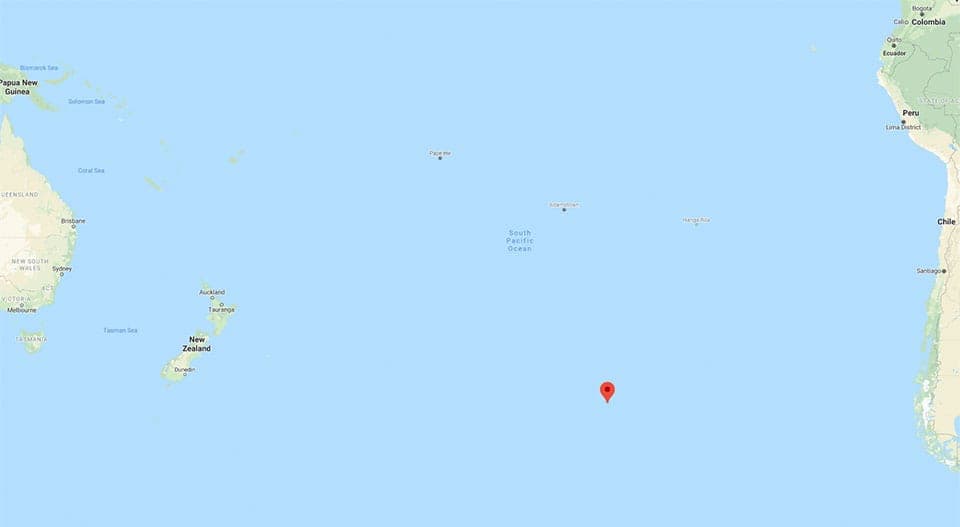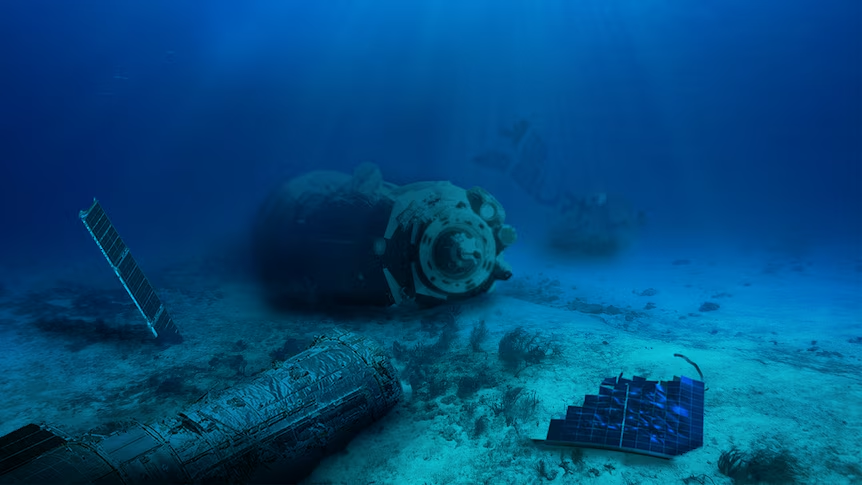Imagine a place on Earth so remote that it’s closer to the astronauts orbiting above us in the International Space Station than any human settlement. This isolated spot, known as Point Nemo, is located in the South Pacific Ocean and holds a secret: it’s the final resting place for decommissioned spacecraft. Welcome to the Spacecraft Graveyard, a fascinating and lesser-known corner of our planet where humanity’s spacefaring relics find their watery grave.
Finding Point Nemo
Point Nemo, officially known as the Oceanic Pole of Inaccessibility, is situated roughly 2,688 kilometers (1,450 nautical miles) from the nearest land. This remote location was calculated by survey engineer Hrvoje Lukatela in 1992, and it’s the ideal place for safely disposing of defunct satellites, space stations, and other space debris. The isolation ensures that any debris that doesn’t burn up upon reentry poses minimal risk to human life or inhabited areas.

A Watery Final Resting Place
The Spacecraft Graveyard is a fitting name for this part of the ocean. Since the 1970s, space agencies have been using this remote area to dispose of their decommissioned equipment. The process of deorbiting a spacecraft involves carefully calculating its descent so that it falls into this vast, uninhabited stretch of water, minimizing the risk of accidents.
- SIZE - Telescope is 5.5 in length and 15 when extended. Antique style High quality spyglass with beautiful case, makes a great gift. Magnification : 25X. Material Used: Solid Brass
- HOW TO USE - This telescope uses push-and-pull mechanism to focus distant objects.
- This 3 draw Brass telescope includes a sliding sunshade cover, which pulls out to reduce glare in bright light.
Prices pulled from the Amazon Product Advertising API on:
Product prices and availability are accurate as of the date/time indicated and are subject to change. Any price and availability information displayed on [relevant Amazon Site(s), as applicable] at the time of purchase will apply to the purchase of this product.
**As an Amazon Affiliate, The History Box may earn a commission through purchases from this link.**
The graveyard contains the remnants of over 260 space objects, a testament to humanity’s enduring quest to explore beyond our earthly boundaries. Among the most notable residents of this underwater cemetery is the Russian space station Mir, which was deliberately deorbited in 2001 after 15 years of service.

Mir: A Pioneering Resident
The Mir space station was one of the Soviet Union’s most ambitious projects, a symbol of their space prowess. Launched in 1986, Mir served as a microgravity research laboratory, a staging ground for cosmonauts, and a beacon of international cooperation. Over its operational lifetime, Mir hosted astronauts from around the world, including the first American to live aboard a Russian space station.
As Mir aged, maintaining the station became increasingly difficult and expensive. By the late 1990s, the decision was made to deorbit the station safely. In March 2001, Mir was guided into a controlled reentry, and its fragments descended into the waters of the South Pacific, joining the growing collection of space debris at Point Nemo.
An International Effort
The Spacecraft Graveyard isn’t just home to Russian relics. It’s an international resting place for a wide variety of spacefaring nations’ equipment. For instance, the European Space Agency (ESA) and NASA have both contributed to this underwater museum.
The European Space Agency’s Automated Transfer Vehicles (ATVs), which were used to supply the International Space Station (ISS), have made their final journeys to Point Nemo. These uncrewed cargo spacecraft were essential for transporting food, water, fuel, and scientific equipment to the ISS, and their missions ended with controlled reentries to the graveyard.
The ISS: A Future Resident?
The International Space Station, a symbol of international cooperation and scientific progress, is expected to end its mission sometime in the 2030s. Given its size and complexity, its deorbiting will be a significant event, and Point Nemo is the most likely destination for its final plunge.
Deorbiting the ISS will require meticulous planning to ensure that its descent is controlled and that it lands safely in the remote waters of the South Pacific. When the time comes, the ISS will join Mir and countless other spacecraft in the deep blue depths of Point Nemo, marking the end of an era of human space exploration.

The Challenges of Deorbiting
Deorbiting a spacecraft is no small feat. Engineers must meticulously calculate the descent path to ensure the spacecraft burns up as much as possible upon reentry. However, large, robust pieces can survive the fiery descent through the atmosphere. For example, parts of Mir’s thick steel hull and other resilient components likely reached the ocean floor intact.
The process involves several stages: reducing the spacecraft’s altitude, positioning it for reentry, and initiating a controlled descent. The goal is to minimize debris spread and ensure it falls within the designated area. Point Nemo’s remoteness makes it the perfect target for this high-stakes maneuver.
Environmental Considerations
One might wonder about the environmental impact of depositing space debris in the ocean. Point Nemo’s location, in the heart of the South Pacific Gyre, is one of the least biologically productive regions in the world. The area’s minimal marine life and vastness help mitigate potential environmental damage.

Furthermore, most spacecraft are designed to burn up almost entirely during reentry. The remnants that do reach the ocean are generally considered to pose minimal environmental risks, though this is an area of ongoing study. Space agencies continue to refine their deorbiting techniques to minimize the ecological footprint.
The Future of Space Debris Management
As humanity continues its exploration of space, managing space debris becomes increasingly critical. Spacecraft graveyards like Point Nemo provide a temporary solution, but long-term strategies are essential. Innovative approaches are being developed, such as using robotic spacecraft to collect and remove debris from orbit.
Organizations like the European Space Agency and NASA are investing in research to track and manage space debris more effectively. Improved materials and spacecraft designs that reduce debris upon reentry are also part of the solution. The goal is to ensure that our explorations leave as little impact on our planet as possible, both in space and on Earth.
Stories from the Graveyard
The Spacecraft Graveyard holds the physical remnants of our space endeavors and the stories and achievements they represent. Each piece of debris is a testament to the missions and the people behind them. From satellites that have revolutionized communication and navigation to space stations that have hosted groundbreaking scientific research, these fallen stars tell a rich history of human innovation and ambition.
Consider the story of the Jules Verne ATV, the first European Automated Transfer Vehicle. Named after the famous science fiction writer, it was launched in 2008 and successfully docked with the ISS, delivering crucial supplies. After completing its mission, it made its final descent to Point Nemo. The Jules Verne ATV symbolizes Europe’s significant contributions to space exploration and international collaboration.
A Space Enthusiast’s Dream
For space enthusiasts and historians, the Spacecraft Graveyard is a fascinating topic. Though inaccessible and unseen, the knowledge of its existence sparks the imagination. It reminds us of the tangible outcomes of our extraterrestrial ventures and the ongoing story of humanity’s quest to explore beyond our planet.
One can picture the deep-sea landscape scattered with pieces of history: a solar panel here, a twisted piece of hull there, each artifact representing a chapter in our journey to understand and explore the cosmos. While Point Nemo remains a distant and mysterious place, its role in space exploration is profoundly significant.
The Broader Impact
The existence of the Spacecraft Graveyard also highlights broader themes in space exploration, such as international cooperation and the shared responsibility of managing space debris. Countries worldwide have contributed to the collection of fallen spacecraft at Point Nemo, emphasizing the collaborative nature of space endeavors.
This cooperation extends beyond simply using the graveyard. The lessons learned from managing decommissioned spacecraft inform policies and practices that ensure the sustainability of space activities. As we look toward a future with more frequent and ambitious missions, including potential manned missions to Mars, the principles of responsible space exploration become even more critical.

